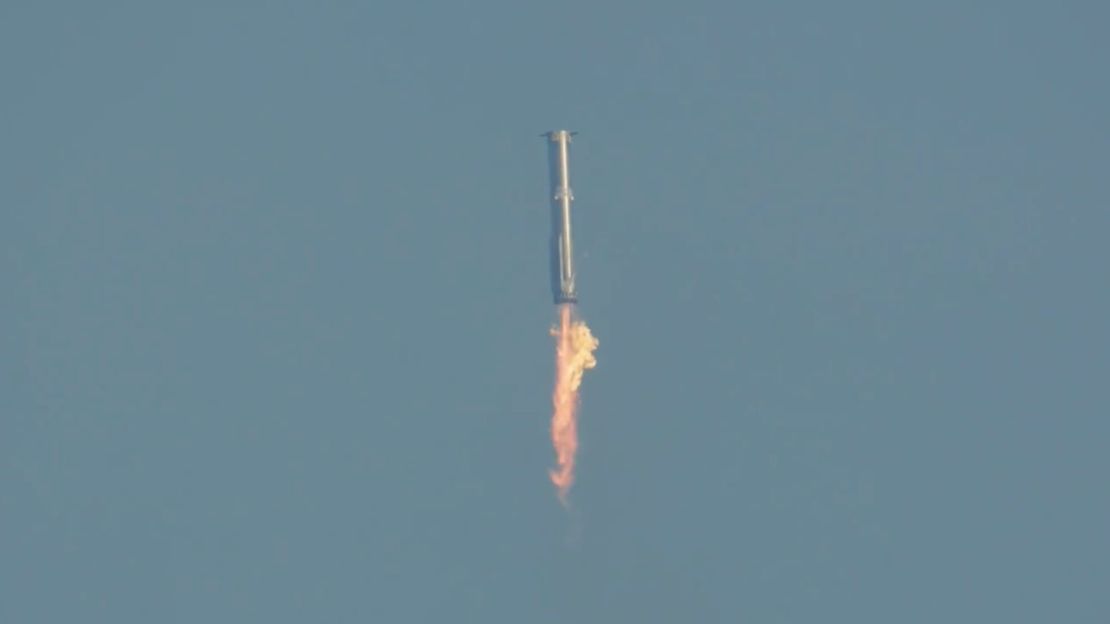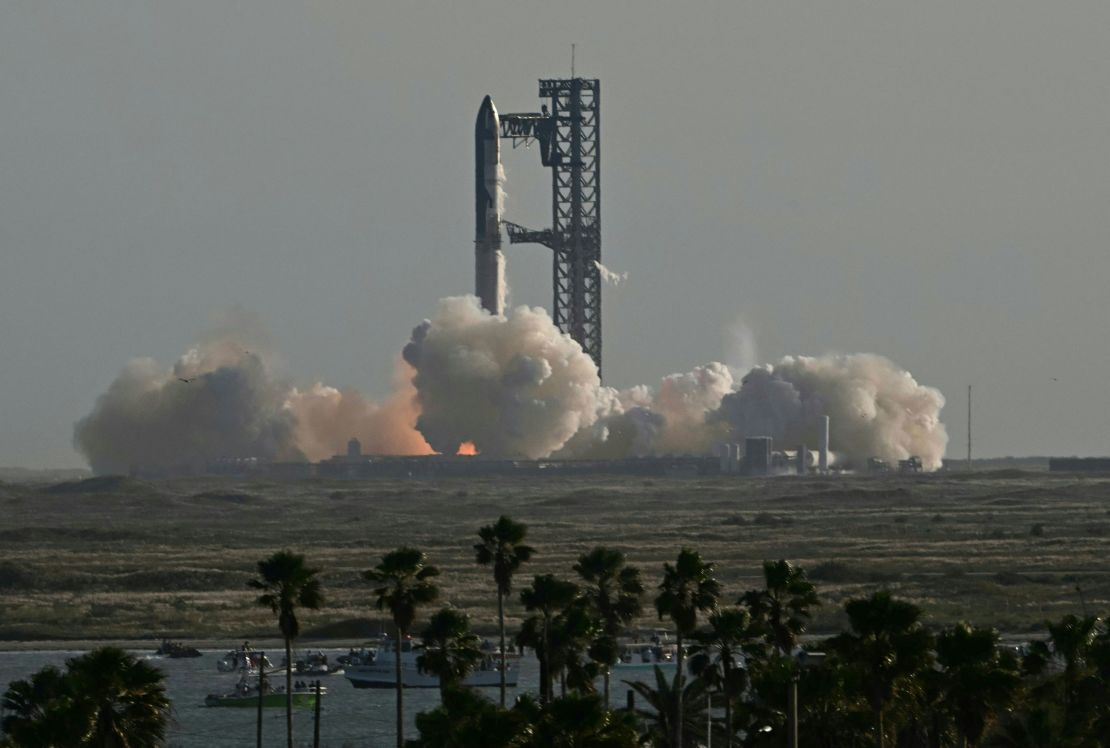Editor’s Note: Relive SpaceX Starship’s sixth test flight here as it happened.
CNN —
SpaceX aborted a highly anticipated booster catch attempt Tuesday during the sixth test of Starship, the most powerful rocket ever built — just weeks after acing the stunning feat on the first try. But the mission went on to soar through new milestones during a roughly hour-long flight.
The nearly 400-foot-tall (121-meter) Starship system — which features the Starship spacecraft stacked atop the Super Heavy booster — lifted off around 5 p.m. ET from the company’s Starbase facility near Brownsville, Texas. President-elect Donald Trump was in attendance, joining SpaceX CEO Elon Musk for the event in another example of Musk’s increasing role in Trump’s orbit.
After firing up its 33 powerful Raptor engines and propelling the Starship spacecraft toward space, the Super Heavy booster separated from the spacecraft, reversed course and steered itself back toward the launch site. SpaceX planned to attempt a precision landing of the booster into the arms, or “chopsticks,” of the launch and landing structure — nicknamed “Mechazilla” by Musk — at the company’s Starbase facility. The company first pulled off the unprecedented maneuver during the fifth Starship test flight last month.
However, this time “automated health checks of critical hardware on the launch and catch tower triggered an abort of the catch attempt,” SpaceX said in a statement Tuesday. “The booster then executed a pre-planned divert maneuver, performing a landing burn and soft splashdown in the Gulf of Mexico.”
The Starship spacecraft, meanwhile, fired up its own six engines before entering a coasting phase as it soared through space. The capsule briefly reignited an engine about half an hour later before bracing for reentry — the process by which it veers back into the thickest part of Earth’s atmosphere — and executing a daring landing.

It’s the first time Starship, a vehicle intended to eventually carry humans to the moon and Mars, has successfully ignited one of its Raptor engines while in space, according to SpaceX.
That’s a big deal, explained Garret Reisman, a former NASA astronaut who now advises for SpaceX.
“They’re finicky little beasts — (the Starship rocket engines) — and it’s not so easy to light them up and shut them down and light them up again,” Reisman told CNN.
Starship then aimed to test its limits as it headed toward splashdown in the Indian Ocean.
“We’re going to fly the ship at an aggressive angle of attack once it’s moving slower than the speed of sound,” SpaceX engineer Jessie Anderson said on the company’s livestream. “This means we’ll be flying nose down instead of our usual belly flop orientation during final descent. This will — no doubt — stress the limits of the flaps’ ability to maintain control, but it will be a chance to get real flight data on what our limits actually are.”
The “flaps” are small wings attached to the side of the Starship vehicle meant to brace the winds of reentry and help slow the vehicle down.
The company had also removed some protective shielding off the vehicle to see whether the Starship could survive without it.
Starship made a safe landing in the Indian Ocean and remained intact despite the rough landing trajectory.
“Turns out the vehicle had more capability than our calculations predicted, and that is why we test like we fly,” SpaceX engineer Kate Tice said on the livestream for the event.
This uncrewed trial marked the fastest turnaround time yet in SpaceX’s test campaign for Starship, which will play a key role in NASA’s cornerstone Artemis program. Aiming to put boots on the moon as soon as 2026, the space agency plans to use the rocket’s upper stage, the Starship spacecraft, as a lunar lander ferrying astronauts to the moon’s surface.

NASA Administrator Bill Nelson referenced Starship’s significance to the Artemis program when congratulating the company on Tuesday’s test flight.
“Congrats to @SpaceX on Starship’s sixth test flight. Exciting to see the Raptor engine restart in space — major progress towards orbital flight. Starship’s success is #Artemis’ success. Together, we will return humanity to the Moon & set our sights on Mars,” Nelson posted on X after Starship’s splashdown.
The goal of these test flights is to hash out how SpaceX might one day recover and rapidly refly Super Heavy boosters and Starship spacecraft for future missions. Quickly reusing rocket parts is considered essential to drastically reducing the time and cost of getting cargo — or ships of people — to space.
The Federal Aviation Administration, which licenses commercial rocket launches, said it did not have to undertake the lengthy process of reviewing a launch license alteration because the flight path of this week’s flight was expected to closely mimic an earlier test.
“The FAA determined SpaceX met all safety, environmental and other licensing requirements for the suborbital test flight,” the agency said in a statement. “The FAA determined the changes requested by SpaceX for (Tuesday’s test flight) are within the scope of what has been previously analyzed.”
The fifth integrated test flight of Starship launched on October 13, garnering international attention with SpaceX’s ambitious attempt to maneuver the 232-foot-tall (71-meter) Super Heavy back to a gargantuan Mechazilla landing structure.
“Starship’s fifth flight test was a seminal moment in iterating towards a fully and rapidly reusable launch system,” the company said in a statement.
Starship is considered crucial to SpaceX’s founding mission of eventually carrying humans to Mars for the first time.

For NASA’s Artemis program, SpaceX has government contracts worth up to nearly $4 billion to complete the task of developing a cost-effective space transportation system.
Starship’s progress and path forwardGreg Autry, the associate provost for space commercialization and strategy at the University of Central Florida, said Starship operations Tuesday evening “looked really good.”
Autry said SpaceX might have opted for a sea landing of the booster out of an “abundance of caution,” with Trump and Musk in attendance.
“I don’t know what the decision-making process was yet of the failure mode or maybe they just want to be careful not to kill the president-elect of the United States by any chance,” he told CNN.
Autry is a rumored candidate for Trump’s NASA administrator pick. In a statement to CNN on Tuesday, the Trump campaign said, “President-Elect Trump is making decisions on who will serve in his second Administration. Those decisions will continue to be announced by him when they are made.”
During the fourth integrated Starship test flight in early June, the spacecraft endured significant damage. The vehicle shed numerous heat tiles designed to shield it from intense temperatures caused by the pressure and friction of reentry.
“Because of lost tiles … the forward flaps were so melted it was like trying to control it with little skeleton hands,” Musk said after that mission, adding that the fourth flight landed roughly 6 miles (9.7 kilometers) away from its intended splashdown site in the Indian Ocean.
SpaceX made significant strides, however, during Starship’s fifth integrated test flight in mid-October.
Ahead of that mission, SpaceX implemented what it called a “complete rework of (Starship’s) heatshield, with SpaceX technicians spending more than 12,000 hours replacing the entire thermal protection system with newer-generation tiles, a backup ablative layer, and additional protections between the flap structures.”
Tuesday’s milestones could cue up SpaceX to begin tackling more ambitious projects, and it remains to be seen how the aborted attempt of the booster catch will factor in to those next steps.
“In 2025, SpaceX plans to undertake a long-duration flight test and a propellant transfer flight test,” according to a recent report from NASA’s Office of the Inspector General, or OIG.
Demonstrating the ability to launch a Starship into orbit and then rendezvous the spacecraft with a tanker carrying fuel is considered essential to the success of NASA’s Artemis program.
For the human moon landing mission, called Artemis III, Starship may need to dock with more than a dozen fuel tankers before continuing its mission to the lunar surface.
SpaceX will also face a “critical design review” for the Artemis III mission next summer, according to the OIG.
Sign up for CNN’s Wonder Theory science newsletter. Explore the universe with news on fascinating discoveries, scientific advancements and more.
CNN’s Kristen Holmes, Tori Powell and Ross Levitt contributed.




































